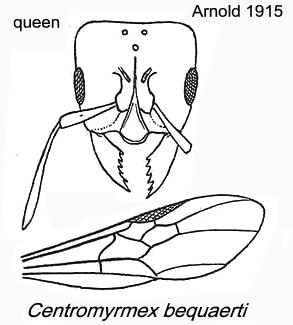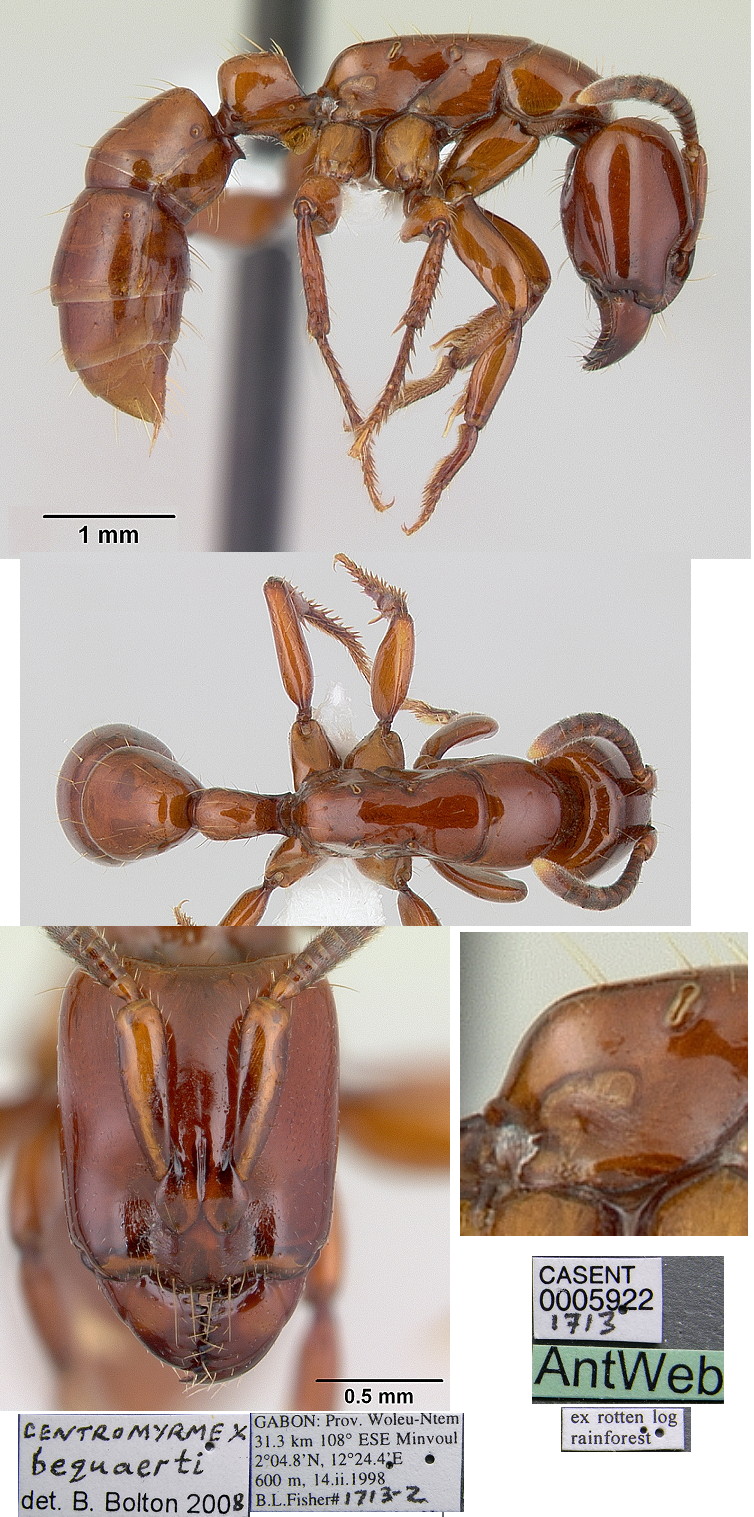
Centromyrmex bequaerti (Forel)
  Type location Zaïre (Glyphophone
bequaerti, Forel, 1913b: 308, wing illustrated, queen) from
Kibombo, by J. Bequaert; junior synonym rufigaster (Arnold,
1916: 163, illustrated, queen; synonymy by Brown, 1963: 10) from Zimbabwe;
queen only described (see Bolton, 1995) Type location Zaïre (Glyphophone
bequaerti, Forel, 1913b: 308, wing illustrated, queen) from
Kibombo, by J. Bequaert; junior synonym rufigaster (Arnold,
1916: 163, illustrated, queen; synonymy by Brown, 1963: 10) from Zimbabwe;
queen only described (see Bolton, 1995)  . .
Forel's (1919b) description is at  . .
Synonymy with Centromyrmex by Brown (1963), who
noted seeing the type and a virtually identical winged female from Zambia
(Mbala [Abercorn], sent to him by Dr Arnold).
Bolton, B. & Fisher, B.L. 2008c. Afrotropical ants
of the ponerine genera Centromyrmex Mayr, Promyopias
Santschi gen. rev. and Feroponera gen. n., with a revised key
to genera of African Ponerinae (Hymenoptera: Formicidae). Zootaxa,
1929, 1-37 - weblink - http://www.mapress.com/zootaxa/2008/f/z01929p037f.pdf
[10 Nov. 2008]
|
 Arnold's
(1915) description (adapted by me) of rufigaster was - Arnold's
(1915) description (adapted by me) of rufigaster was -
"Queen - TL 14 mm. Head black, slightly castaneous on the clypeus;
thorax black, petiole dark reddish brown, gaster castaneous red; legs,
scapes and mandibles castaneous, the margins of the latter blackish,
funiculus dark brownish red, the apical joint paler. Smooth and very
shining. Exceedingly sparsely and finely punctured, the piligerous
punctures larger than the others; the extreme anterior margin of the
mesonotum finely and rather closely punctured. Pilosity very sparse,
consisting of stout, suberect, yellowish hairs, fairly long on the
pronotum and abdomen, shorter elsewhere. A very scanty pubescence on
the legs and antennae.
Head, excluding the mandibles, as long as wide behind, wider behind
than in front) posterior margin very shallowly concave, the angles
rounded. Eyes large, not very convex, placed in the middle of the
sides, ocelli present. An oblique and shallow groove or elongate fovea
lies on the inner border of each frontal carinae, along the posterior
half. First joint of funiculus as long as wide, 2nd-9th joints wider
than long, 10th about as long as wide, the apical joint twice as long
as wide, as long as the 9th and 10th together. Pronotum widely exposed
above, convex transversely and lengthwise; mesonotum moderately convex,
the parapsidal sutures feeble. Scutellum trapezoid its posterior margin
convex, sloping downwards posteriorly and hardly raised above the level
of the metanotum; the latter rather long, quite one-quarter the length
of the scutellum. Propodeum sloping from its base downwards, merging
into the declivity by a deep curve, wider than long, shorter than the
declivity, the latter convex transversely and vertical. Petiole twice
as wide as long, wider above than below, the dorsal surface moderately
convex transversely and lengthwise; the anterior face vertical, concave
dorso-ventrally and convex transversely; posterior face very steep or
almost vertical; ventral lamella produced into a large triangular
tooth. Base of gaster subtruncate, slanting & little forwards (as
also the petiole). Abdomen elongate, cylindrical, parallel-sided, two
and four-fifths longer than wide, the constriction between the 1st and
2nd segments feeble. Wings dirty yellowish, nervures dark brown, stigma
black.
Other characters as for the sub-genus.
Victoria Falls. Type in my collection. I retain this species under the
genus Glyphopone, since it appears to me that its points of
resemblance with that genus (metatarsal and tibial spines, the polished
integument, and structure of the node) are of greater value than the
points of difference".
The photomontage is collated from http://www.antweb.org/specimen.do?name=SAM-ENT-0011510A
|
Also from Kasongo, Zaïre, by Pons (Wheeler, 1922).
Now known from Cameroun, collected by the Campo
Forest study (Bolton, Dejean & Ngnegueu, 1992), ten instances from
active termitaria of Ophiotermes mandibularis and two from
abandoned termitaria of the same species.
|
 The photomontage is collated from - http://www.antweb.org/specimen.do?name=casent0005922
The photomontage is collated from - http://www.antweb.org/specimen.do?name=casent0005922
Collection details - Locality: Gabon: Woleu-Ntem; 31.3 km 108°
ESE Minvoul; 02°04'48"N 012°24'24"E, 600m. Collection Information:
Collection codes: BLF1713. Date: 14 Feb 1998. Collected by: B.L.Fisher.
Method: EC13 ex rotten log. Habitat: rainforest. of undetermined species
This is the specimen given as a worker of C.
bequaerti in Bolton & Fisher (2008, Fig 1-2). I am assuming the
specimens were associated with a recognisable queen, as. Bolton &
Fisher state only that they measured queens that were "somewhat larger
than the largest workers in associated series" but they gave no precise
collection data. Also from their comments this is a "smaller worker",
with the petiole longer than high..
|
 The
photomontage is collated from http://www.antweb.org/specimen.do?name=CASENT0102992. The
photomontage is collated from http://www.antweb.org/specimen.do?name=CASENT0102992.
In October 2007, as there was no published description of the worker of
this species, I thought this might be a separate species but the
specimen appears to be among those listed as examined by Bolton &
Fisher (2008: 11). Apparently one of the larger workers.
|
|